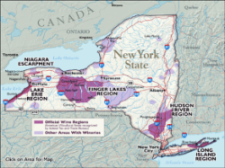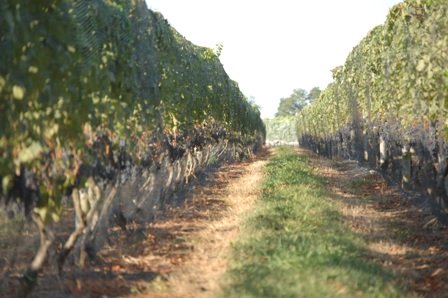|
New York Red Wine is Building a Following Try One and You Will See Why
New York Red Wine go to: New York red wine refers to wine made from grapes grown in the U.S. state of New York. New York ranks third in grape production by volume after California and Washington. Eighty-three percent of New York's grape area is Vitis labrusca varieties (mostly Concord). The rest is almost split equal between Vitis vinifera and French hybrids. During the past thirty years, the increased planting of Vitis vinifera varietals has led to a dramatic increase in the quality of New York red wines.
New York State's wine production began in the 17th century with Dutch and Huguenot plantings in the Hudson Valley region. Commercial production did not begin until the 19th century. New York is home to the first bonded winery in the United States of America, Pleasant Valley Wine Company, located in Hammondsport. It is also home to America's oldest continuously operating winery, Brotherhood Winery in the Hudson Valley which has been making wine for almost 350 years. Furthermore, New York State is home to North America's oldest dedicated sacramental winery, O-Neh-Da Vineyard, now operated by Eagle Crest Vineyards on Hemlock Lake in the Western Finger Lakes region.

Regions The state has four major wine-growing regions, including Lake Erie AVA on the western end of the state, the Finger Lakes AVA in the west-central area, the Hudson River Region AVA in eastern New York, and the eastern end of the Long Island AVA. In 1976, when the Farm Winery Law was passed, the Finger Lakes and Long Island regions had 19 wineries. By 1985, there were 63 wineries, and now the regions hold approximately 212 wineries. The wine regions' soils originated from the last glacial advance which left gravel and shale type soils with heavy clay deposits in the Finger Lakes region and sandy soil in the Long Island region. The climate differs amongst the regions based on the Atlantic Gulf Stream and the numerous bodies of water and mountainous regions around the state. The annual precipitation ranges from 30 inches (76 cm) to 50 inches (127 cm). The growing season in the Lake Erie and Finger Lakes regions ranges from 180 to 200 days a year, while on Long Island, the season is extended to 220 days and the humidity is higher and the fall precipitation is somewhat higher as well.The Lake Erie AVA Is an American Viticultural Area that includes 2,236,800 acres (905,200 ha) of land on the south shore of Lake Erie in the U.S. states of Ohio, New York, and Pennsylvania. Over 42,000 acres (17,000 ha) of the region are planted in grapevines, predominantly in the Concord varietal. Grapes were first cultivated in the area in the early 19th century, and many wineries survived Prohibition in the 20th century by legally selling grapes to home winemakers or illegally selling wine to consumers in Canada. The New York red wine industry in the Lake Erie region did not thrive after the repeal of Prohibition, however, and by 1967 there were fewer than 20 commercial wineries in the area. Recently, Lake Erie wineries have begun planting and vinifying Vitis vinifera varieties in an attempt to improve wine quality.The Finger Lakes AVA Is an American Viticultural Area located in Upstate New York, south of Lake Ontario. The Finger Lakes encompass eleven glacial lakes, but the area around Canandaigua, Keuka, Seneca, and Cayuga Lakes contain the vast majority of vineyard plantings in the AVA. Cayuga and Seneca Lakes each have their own American Viticultural Areas completely contained within the Finger Lakes AVA (Cayuga Lake AVA and Seneca Lake AVA). The Finger Lakes AVA includes 11,000 acres (4,452 ha) of vineyards, making it New York State's largest wine growing region.The Finger Lakes AVA wine region Is often compared to the Rhine wine growing region of Germany. Riesling, one of the most important commercial grape varietals grown in Germany, is also one of the most successful grape varieties grown in the Finger Lakes AVA. Viticulturists in the Finger Lakes region grow a wide variety of grapes besides Riesling, including other European Vitis vinifera grapes, native American grapes, as well as French-American hybrid varieties.The deep lakes in the region help to moderate the local microclimate. Stored heat is released from the deep lakes during the winter, keeping the local climate mild relative to surrounding areas and preventing early season frost. Most vineyards are planted on steep hillsides overlooking the lakes, which help provide the vines with good drainage, better sun exposure, and a reduced risk of frost. The region averages over 30 inches (76 cm) of precipitation a year. The soil in the region is generally deep, providing good drainage, however there are some areas, such as on the west side of Seneca Lake, where the bedrock is close to the surface. The Hudson River Region AVA Is an American Viticultural Area around the Hudson River in eastern New York. The region is home to the oldest continuously operating winery in North America, the Brotherhood Winery, established in 1839. The oldest continusously cultivated vineyard in North America is also located in the Hudson River Region AVA, and is today operated by Benmarl Winery. Most vineyards in the region are located within 2 miles (3.2 km) of the river. The Hudson River flows from north to south, and most vineyards are planted on hills on the western side of the river, where early morning sunshine can rapidly warm the vines. Ocean breezes channeled north up the river help to moderate the climate in the region, making it cooler in the summer and warmer in the winter than surrounding areas. The most important grape varieties in the area are French hybrids and cool-climate Vitis vinifera varieties.The Long Island AVA Is an American Viticultural Area encompassing Nassau and Suffolk counties of New York, including the smaller offshore islands in those counties. The AVA was established in 2001, over 15 years after two smaller AVAs were created at the eastern end of Long Island. The Long Island AVA designation was promoted as a benefit for some wineries located just outside the two smaller AVAs and for wineries that wanted to create wines that use blends from vineyards in different parts of the island. It was also developed and promoted as a consumer protection of the Long Island name; AVAs require that a minimum of 85% of the fruit used in the designated wine is grown within the borders of the region. The "Long Island" AVA was authored by veteran Long Island winemaker Richard Olsen-Harbich who also authored the "The Hamptons, Long Island" and "North Fork of Long Island" AVAs in the mid 1980's. Vineyards on Long Island benefit from the moderating influence of the Atlantic Ocean, Long Island Sound, and Peconic Bay on the local climate.Wines New York red wines very as the regions allow for the red grapes to blossom into red wines that match the great vines of California, Washington, Oregon as wellas the old wine world. The New York red wines one will find are: Merlot, Pinot Noir, Cabernet Sauvignon, and Baco Noir.
New York Red Wine go to: Thank you Wikipedia for the content on this page
Return From New York Red Wine to Types of Red Wine
|
Sign up for weekly Red Wine Reviews
CLICK HEREWe will send you the extremely popular Red-Wine-Home tasting terms when you sign-up.





 History
History